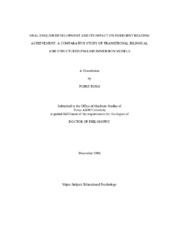| dc.contributor.advisor | Lara-Alecio, Rafael | |
| dc.creator | Tong, Fuhui | |
| dc.date.accessioned | 2010-01-14T23:55:49Z | |
| dc.date.accessioned | 2010-01-16T00:06:16Z | |
| dc.date.available | 2010-01-14T23:55:49Z | |
| dc.date.available | 2010-01-16T00:06:16Z | |
| dc.date.created | 2006-12 | |
| dc.date.issued | 2009-05-15 | |
| dc.identifier.uri | https://hdl.handle.net/1969.1/ETD-TAMU-1114 | |
| dc.description.abstract | This quantitative study derived from an on-going federal experimental research
project targeting Spanish-speaking English language learners (ELLs) receiving services
in four program models: control/experimental transitional bilingual education (TBE) and
control/experimental structured English immersion (SEI). The purpose of my study was
(a) to capture the growth trajectory and rate of oral English acquisition, (b) to investigate
the role of oral English development in acquiring English reading skills, and (c) to
compare program models in order to identify practices that promote ELLs’ English oral
and reading competency at the early elementary level. Structural equation modeling was
utilized. Participants consisted of 534 Spanish-speaking ELLs who started at
kindergarten and continued through first grade in their respective models.
Striking similarities were found among the four instructional models that English
oral proficiency improved significantly (p < .05) in a linear fashion over two years.
However, the magnitude differed in that the experimental TBE demonstrated a steeper growth (p < .025) than that of the control group that started at the same level. Even
though experimental SEI group started at a much lower level in oral English, they
progressed at a rate significantly higher (p < .05) than that of the control group.
In relation to English reading comprehension, for experimental SEI groups, the
initial level of English oral proficiency is of great concern in reading achievement (p
< .05). For both TBE groups, effective intervention is desired because the growth of
English oral proficiency strongly impacts reading achievement (p < .05), and, in addition,
initial level strongly predicts reading comprehension.
The intervention was successfully implemented so that students advanced to a
substantial amount in academic English oray. It is also evident that first language (L1)
instruction did not impede the learning of a second language. On the contrary, for those
students receiving a larger proportion of L1 instruction, alterations in program models
are needed to nurture English oracy at a faster rate of growth, which in turn facilitates
English literacy acquisition. Findings also indicate that without effective English
intervention, students placed in control TBE classrooms remain below all the students in
oral English proficiency. | en |
| dc.format.medium | electronic | en |
| dc.format.mimetype | application/pdf | |
| dc.language.iso | en_US | |
| dc.subject | Oral English | en |
| dc.subject | Reading comprehension | en |
| dc.subject | English Language Learners | en |
| dc.subject | linear trajectory | en |
| dc.subject | structural equation modeling | en |
| dc.subject | program effectiveness | en |
| dc.title | Oral English development and its impact on emergent reading achievement: a comparative study of transitional bilingual and structured english immersion models | en |
| dc.type | Book | en |
| dc.type | Thesis | en |
| thesis.degree.department | Educational Psychology | en |
| thesis.degree.discipline | Educational Psychology | en |
| thesis.degree.grantor | Texas A&M University | en |
| thesis.degree.name | Doctor of Philosophy | en |
| thesis.degree.level | Doctoral | en |
| dc.contributor.committeeMember | Eslami, Zohreh | |
| dc.contributor.committeeMember | Irby, Beverly J. | |
| dc.contributor.committeeMember | Nash, William R. | |
| dc.contributor.committeeMember | Pollard-Dorudola, Sharolyn | |
| dc.type.genre | Electronic Dissertation | en |
| dc.type.material | text | en |
| dc.format.digitalOrigin | born digital | en |


